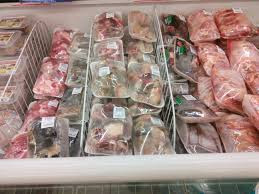Fat Free Foods.
Fat Free products can be deemed as being healthy for you but this doesn't mean to say they are. The fat extracted from fat free products is replaced with a load of sugar to help improve the flavour. So your intake of calories when eating these "fat free foods" stays the same if not becomes higher as does the levels of sugar in your body.
Dried Fruit.
When fruit is dried out to keep for a longer period of time it looses a lot of valuable vitamins and minerals. The dried fruit is seasoned with sugar to hide the original bland taste of the fruit. Dehydrated fruit does not provide your body with the vitamins and minerals it needs whilst at the same time increasing your sugar levels. Better off sticking to a fresh piece of fruit.
Granola.
This cereal filled with oats, nuts, honey and rice will increase your diet with a load of sugars and Trans fats. Large portions of Granola over a period of time is not good for your health and can increase the risk of you having heart disease or a stroke.
Diet Drinks.
Instead of sugar, diet drinks are filled with artificial sweeteners which can mislead people into believing that diet drinks can help you loose weight and should prevent diseases like diabetes. But this is not the case. Artificial sweeteners triggers the body to release insulin which can lead to weight gain rather than weight lose. Diet drinks are also very acidic and can cause irreversible damage to the enamel which protects your teeth from harmful chemical and high temperatures. A study published in 2008 followed 9,514 people around for 9 years who drank diet drinks. The study showed that people who drink artificial sweetened drinks have 36% more risk of becoming diabetic.
Health/Energy Bars.
Thought to be the perfect workout snack some health/energy bars are good for us while a lot of them aren't. Some contain very high sugar levels along side saturated fats which can clog up arteries. Specifically meal replacement bars contain these high levels and are best to be avoided.
Energy Drinks.
Energy drinks such as Monster, Red Bull and RockStar contain certain herbs and vitamins that can cause long term side affects on your body which aren't fully understood yet.The most common ingredient found in these drinks is caffeine, too much of it can cause heart palpitations and can create a irregular heart beat. Some people can even become tired after consuming too much energy juice due to the body constantly producing energy. High sugar levels are also found in these drinks increasing the risk of diabetes. So long as energy drinks are used responsibly these side affects are most likely to be avoided. I know of two older men who had a bet on with each other that one of them couldn't drink 6 large cans of Monster in under 1 hour. The man who accepted the challenge had drunk 4 cans of this energy juice in about 30 minutes and began to complain that his heart beat was racing uncontrollably and that he thought he was going to die. I watched him do this first hand advising him with other people not to go ahead with this. He went to a local chemists/ Drug store to see if there was anything he could take or do to slow down the rate of his heart. Unfortunately for him there was nothing and he had to deal with what he had just put in his body. Luckily enough the effects died down and he regained full control of his body. This stuff in my opinion should be totally avoided and has to be taken very seriously.
Frozen Foods.
Food can be frozen to help increase the products life span. During the freezing process foods loose a large amount of vitamins and minerals. So if you are on a strict diet of frozen fruit and veg it is suggested that you also take vitamin supplements along side your meals. It is usually frozen fruit and veg which cause the most problems in our diets. Many frozen meals also have small amounts of calories which can lead to unhealthy snacking and may cause difficulties in controlling your weight size. If you use frozen foods it is recommended that you should avoid low calorie frozen meals or if you do choose to buy them make sure that they are low in sodium (salt). High amounts of salt in your diet can cause your body to hold extra water it doesn't need causing high blood pressure which may lead to heart disease or a stroke.
Fruit Juice.
I'm sure if you were to go into a shop and pick up some juice labelled 100% Fresh you would assume it was good for you. Tropicana for example is a huge leader in producing orange juice. How can every single bottle they produce be fresh? Well hears the secret. After the oranges have been squeezed dry the fruit juice left over is stored in massive holding tanks where the oxygen is removed from the juice to increase the time it can be held for. After a period of time the juice left in the tank starts to taste very bland so "flavour packs" are added to the mixture. Flavour packs are made from orange essence and oils and are made by flavour and fragrance companies, the same companies who make perfume for Doir and Calvin Klein. The flavour packs are added to the tanks to enhanace the flavour of the juice making it seem "fresh". You would be better off just eating a bit of fruit instead of drinking fruit juice. Fruit juice can contain just as much or sometimes more sugar and calories than fizzy/soft drinks. The large amounts of sugars out way the small amounts of vitamins and minerals our body receives when we drink fresh juice.
























